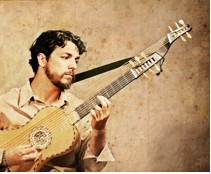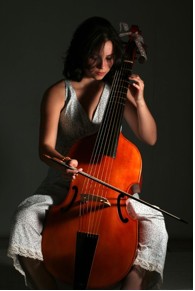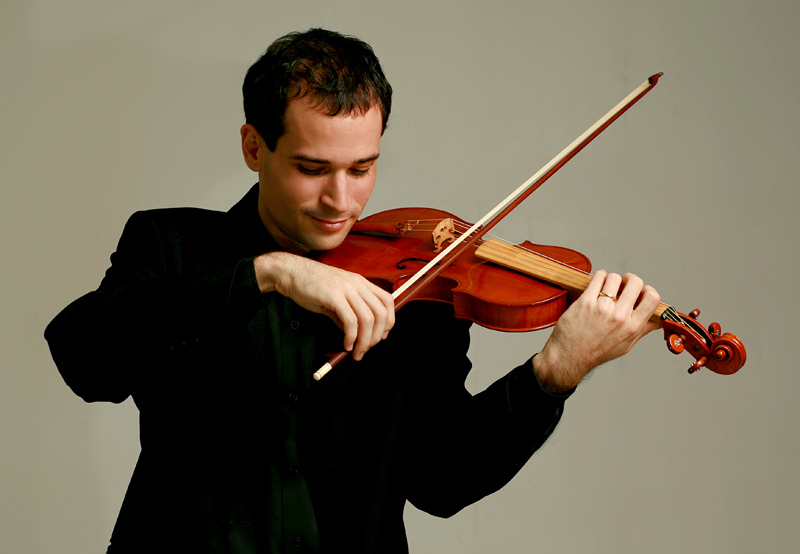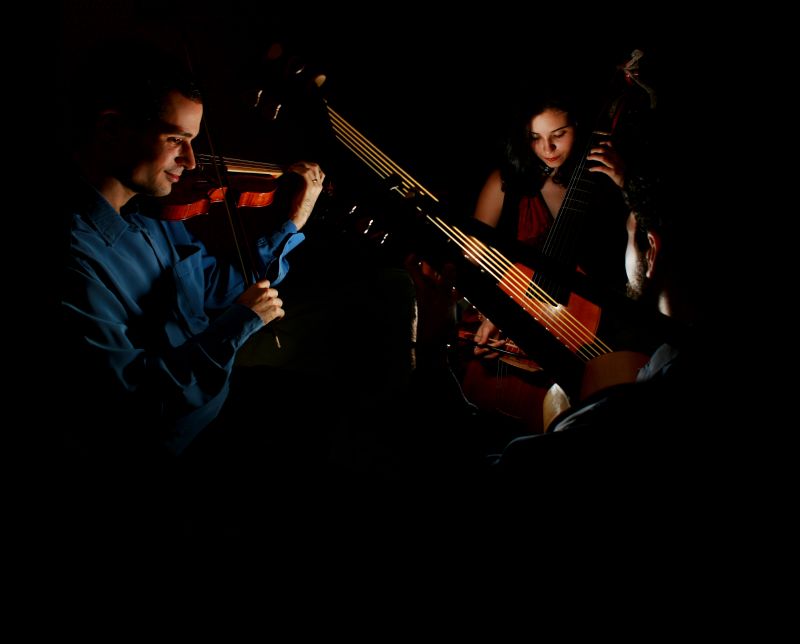Buy now!
|
Theorboed guitar:
Felippe Maravalhas (e-mail)

Viola da gamba:
Iara Ungarelli

Baroque violin:
Zoltan Paulinyi

Pictures by Marcelo Versiani (2007-2008).

|
|
SONARE Ensemble
CD 2009
Suonate di celebri auttori
Booklet in Portuguese, English, French.
Francesco
Maria Veracini (1690-1768) |
|
Sonata IX |
#
ISRC # |
| |
[1] |
Allegro Moderadamente (4:46) |
BR-ZOL-09-00001
|
| |
[2] |
Adagio (1:00) |
BR-ZOL-09-00002 |
| |
[3] |
Scozzese (9:11) |
BR-ZOL-09-00003
|
| |
|
|
|
| Christian Gottlieb Scheidler
(1752-1815) |
|
Duo pour guitare et violon
|
|
| |
[4] |
Allegro (6:44) |
BR-ZOL-09-00004 |
| |
[5] |
Romance (2:56) |
BR-ZOL-09-00005 |
| |
[6] |
Rondo (2:54) |
BR-ZOL-09-00006 |
| |
|
|
|
| Christian Gottlieb Scheidler
(1752-1815) |
|
Sonate pour la guitare n. 1 |
|
| |
[7] |
Allegro (6:44) |
BR-ZOL-09-00007 |
| |
[8] |
Romance (2:56) |
BR-ZOL-09-00008 |
| |
[9] |
Rondo (3:05) |
BR-ZOL-09-00009 |
| |
|
|
|
| Giacomo Antonio Tinazzoli
(1673-1730) |
[10] |
Sonata |
BR-ZOL-09-00010 |
| |
|
|
|
| Johann Sebastian Bach
(1685-1750) |
|
Sonata BWV 1001 |
|
| |
[11] |
Adagio (3:50) |
BR-ZOL-09-00011 |
| |
[12] |
Fuga (5:35) |
BR-ZOL-09-00012 |
| |
[13] |
Siciliano (3:37) |
BR-ZOL-09-00013 |
| |
[14] |
Presto (4:59) |
BR-ZOL-09-00014 |
| |
|
|
|
| Giuseppe Vaccari
(1704-1766) |
|
Concerto a Mondolino e basso |
|
| |
[15] |
Allegro (4:31) |
BR-ZOL-09-00015 |
| |
[16] |
Andante (3:46) |
BR-ZOL-09-00016 |
| |
[17] |
Giga (2:42) |
BR-ZOL-09-00017 |
| (Duração total: 69:14) |
|
|
|
Thanks to our sponsors:
Cordas Aquila (Ernesto Ett
- Brasil)
FAC-GDF (Fundo de Apoio à
Cultura)
|
|
REPERTOIRE
Twenty-three years after the publication of the collection
“Sonate a violino solo e basso” - opera prima, Francesco Maria Veracini
published, in London (1744), twelve sonatas entitled “Sonate Accademiche”
- opera seconda, dedicated to the king Frederick Augustus III. Within the later,
Sonata IX in A major begins with a gracious Allegro filled with appoggiatoras
and ornaments to challenge the violinist. In the Adagio only the first and last
two bars are written, leaving the interpreter to improvise a cadenza or capricci
to interconnect them. Following, in attacca, is the last movement, entitled
Scozzese, a Scottish theme followed by two variations. It is abruptly interrupted
by a Largo in A minor, substituting what would be a minor variation, to only
then return to the Scozzese theme which develops until a brilliant coda.
Christian Gottlieb Scheidler performed professionally as cellist and bassoonist
at the electoral court in Mainz, though also known as composer, lutenist and
guitarist, having lecturer in guitar at Frankfurt. He lived during a period
in which the baroque lute had practically disappeared and was the last composer
to publish pieces for this instrument. There are few accounts about his life
and no one is sure as to how many strings had the guitar he played. His sonatas
use the sixth string tuned in G, a second below the fifth string (A), a characteristic
typical of instruments with various bass strings such as the baroque lute or
the Décacorde. It is possible that Scheidler played a guitar with more
bass strings, since he was accustomed to the thirteen course of the lute, and
having had his sonatas published for the six-string guitar which was an instrument
more readily available to his students and compatriots. In these sonatas, melodic
phrases appear in the bass which, abruptly, change octaves, corroborating with
the speculative hypothesis that he conceived them for an instrument with more
strings. In this recording, I have taken the liberty to play some bass notes
one octave lower to give value to his melodic phrases and to make the pieces
more idiomatic for the therboed guitar.
The period in which he worked in as chapel master for the prince
Leopold von Anhalt-Köthen was highly productive for the secular music of
Johann Sebastian Bach. In 1720, the year his first wife dies, Maria Barbara,
Bach concludes “Sei Solo a violino senza basso accompagnato”. The
work is composed of three sonatas and three partitas interweaved. Musicologists
believe that there is numerological evidence, based on the gematria or numerical
alphabet, which identify the three pairs of sonatas and partitas with the liturgical
seasons of Christmas, Easter and Pentecost. Some allege, although there is controversy,
the work was a tombeau or epitaph for Maria Barbara. In the piece there are
citations of various choirs combined to melodic phrases from the Easter anthem
“Christ lag in Todesbanden” (Christ lay in death’s bonds).
The first sonata, in G minor, begins with a declamatory Adagio announcing, with
rhetorical resources, the melancholic theme of the work. This is followed by
a brilliant Fuga constructed from a short motif of four repeated notes. The
Siciliano, in the tonality of B flat major, is expressed with a tranquil serenity
though, rather than bringing joy, serves more to calm the melancholy of the
sonata, which concludes turbulently with an impetuous Presto, filled with ambiguous
accentuation, where the phrases articulate between tertiary and binary forms,
in an emotional and eloquent moto-perpetuo. Transcriptions and adaptations were
very common in Bach’s musical universe, as depicted by Johann Friedrich
Reichardt (1752 - 1814) about the violin sonatas and partitas, Bach “always
played them on the harpsichord, adding harmonies where he thought necessary”,
exemplified by the transcriptions in the version for Lautenwerk (BWV1006a) in
the 3rd partita for the violin (BWV1006). The Fuga of Sonata I (BWV1001) was
transcribed for the lute by Johann Christian Weyrauch, a friend of Bach. Since
the lautenwerk (a harpsichord with gut strings) and the baroque lute possess
a very similar tone to that of the therboed guitar, a transcription of Sonata
I for this instrument is wholly justified. In the transcriptions registered
in this CD, as was done with Scheidler’s sonatas, some bass notes were
played in octaves due to the tessitura of the therboed guitar.
The manuscript entitled “Suonate di Celebri Auttori”
(1759) by Filippo Dalla Casa contains a number of pieces for the Arcileuto Francese,
as well as some sonatas and concertos for the mandolino and thourough bass.
In those days, what was designated as a mandolino or mandola served equally
for instruments with six courses tuned in fourths such as the lute, as for instruments
with four courses tuned in fifths such as the violin. Regardless of the evidence
and that Dalla Casa most likely foresaw the use of an instrument tuned in fourths,
due to a lutenist’s quick adaptability, there would have been no impediments
for this repertoire to be played by a mandolino tuned in fifths. The mandolin,
the modern version of the mandolino, is tuned like the violin. Such tuning was
gradually established as the standard, due possibly to the violin’s prestige
during the 18th Century when the repertoire for both instruments was frequently
interchanged. In this manuscript of Dalla Casa appears a beautiful sonata for
the mandolino by Giacomo Antonio Tinazzoli, albeit short, is structured like
a small concerto, where the mandolino solos expressively between the “tutti”
in a style reminiscent of Vivaldi’s. Another piece extracted from the
manuscript is the concerto in D major for the mandolino by Giuseppe Vaccari,
a lovely example of a gallant sonata, full of childlike grace and festive spirit.
ABOUT THE THEORBOED GUITAR
During the 17th and 18th Centuries, the baroque guitar enjoyed
much prestige within French, Spanish, English and Italian secular music, to
the point where monarchs such as Louis XIV and Charles II became enthusiasts
of this instrument. Moreover, another instrument with a lower register which
was also recurrently used during this period was the Italian Tiorba, frequently
played in conjunction with the guitar accompanying in thourough bass. Since
both instruments possess five strings with the same tuning, it was very common
that the same musician could play both. Within this context, arose a hybrid
between the guitar and the theorbo: the therboed guitar.
There are numerous references on therboed guitars in tablature
books, the eldest possibly being that in the Balletto Detto L’ardito Gracioso
of the “Libro Quarto de Intavolatura di Liuto” (1616) by Pietro
Paolo Melli, which contains a part written for the Citara Tiorbata. Examples
of solos appear in the “Soavi Concerti di Sonate Musicale per Chitara
Spanuola” (1659) by Giovanni Battista Granata, which contains five pieces
for the Chitara Atiorbata; or in the manuscript by Henry François Gallot
(1660-1684) where twelve pieces appear for the Guitare Theorbée. However,
the tuning of this instrument appears only to have reached a common standard
in the 18th Century. The tuning described by Ludovico Fontanelli in his “Sonate
per Chitarrone Francese” (1733), corresponds to that of the Décacorde,
an instrument described by Ferdinando Carulli (1770-1841) in his “Méthode
Complète pour le Décacorde” Op. 293, the instrument being
the Guitare Theorbée with organological characteristics of the guitars
of the 19th Century.
Hence it leads one to suppose that France was where the therboed
guitar most developed, since Fontanelli used the term Chitarrone Francese nearly
a century after Carulli published his Op. 293 in Paris, as well as that the
oldest exemplar of a Guitare Theorbée is that of an anonymous French
luthier, dated approximately to 1760 (part of the collection of the museum Cité
de la Musique in Paris).
CURRICULA
Iara Ungarelli (viola da gamba)
Iara Ungarelli was born in Brasilia, 1989. She began studying
music in 1998 at the Escola de Música de Brasília - EMB (Music
School of Brasília), where she has been studying the Viola da Gamba since
1999 under the orientation of Cecília Aprigliano. Ungarelli joined the
EMB’s Band of Ancient Music for eight years. She has studied with Judith
Davidoff, Ricardo Rodriguez and Mário Orlando Guimarães during
the International Summer Courses realised by EMB in 2004 and from 2006 to 2008,
respectively. Concurrently, she studied with Philippe Pierlot at the 18th Colonial
Brazilian Music and Ancient Music International Festival in Juiz de Fora in
2007. Ungarelli integrates both the viola da gamba group - Gambas Candangas,
since its foundation in 2006, and the Grupo Sonare since early 2008. She plays
the whole family of violas da gamba, including the Pardessus de Viole. Her violas
da gamba were crafted by the luthier Roberto Guimarães in 2006 (Bass
Viola da Gamba) and 2008 (Pardessus de Viole).
Felippe Maravalhas (theorboed guitar)
Felippe Maravalhas was born in Brasilia, 1975, graduating in 1999 from the
University of Brasilia with a Bachelor of Arts in guitar, under the orientation
of Eustaquio Grilo. He studied with renown guitarists such as Eduardo Isaac,
Eduardo Fernandez, Fábio Zanon and Luz Maria Bobadilla. Maravalhas is
graduated in lute from the Escola de Música de Brasília, where
he studied with Fernando Dell’Isola, with whom he has a duo named INTAVOLATVRA.
He has studied the lute and baroque guitar with Regina Albanez at the 16th and
18th Colonial Brazilian Music and Ancient Music International Festivals of Juiz
de Fora, where he participated in masterclasses with Luís Otávio
Santos and Philippe Pierlot. In 2004, Maravalhas requested to the luthier Luciano
Faria a replica of the Guitare théorbée (inventary number E.980.2.296)
dated from 1760 of an anonymous luthier, part of the collection of the museum
Cité de la Musique in Paris which is believed to be the first to be built.
Zoltan Paulinyi (violin)
http://www.Paulinyi.com
Zoltan Paulinyi (b. 1977) is from Belo Horizonte, where he was a pupil of
the violinist Ricardo Giannetti. Encouraged to dive into the baroque aesthetic
by Manfred Kraemer in Curitiba and by Micaela Comberti at Dartington (UK) Festival
in 1999, he has often appeared as a performer of the Juiz de Fora Baroque Orchestra
directed by Luís Otávio Santos since 2001. Winner of the Goiânia
National Competition of 2002, Paulinyi is currently violinist for the Symphonic
Orchestra of the National Theatre of Brasília since 2000. He plays on
a baroque violin and bow made by Carlos Del Picchia.
English translation by Pedro Chilton Coimbra.



